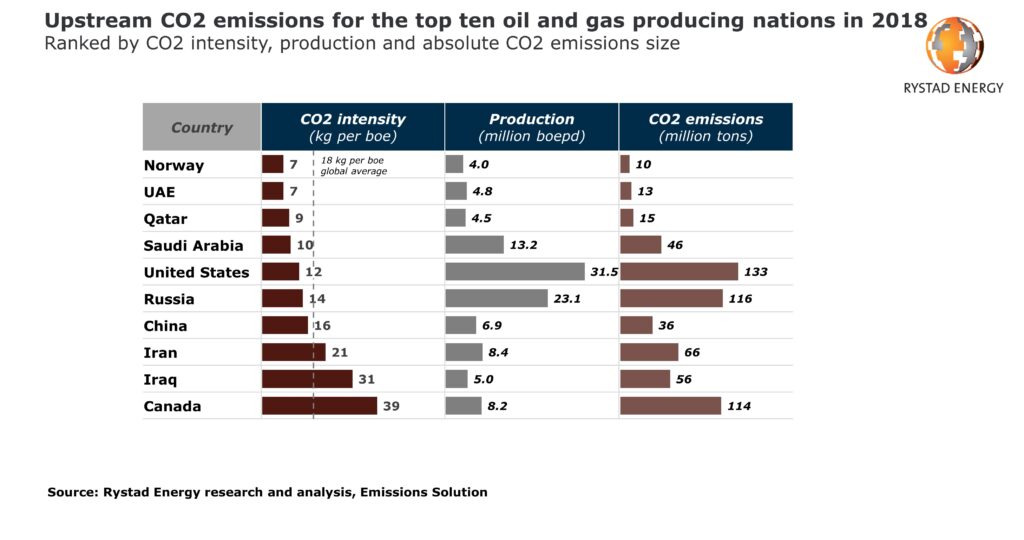The US was the world’s largest CO2 emitter from oil and gas in absolute terms in 2018. Among the top 10 oil and gas producing countries, Canada had the highest CO2 emission intensity per barrel of oil equivalent (boe) produced, while Norway had the lowest, latest data by Rystad Energy shows.
For 2018, the year with the latest reliable data, the world’s top emitters from upstream oil and gas producing activities in absolute terms were:
- US (133 million tons of CO2), followed by
- Russia (116 million tons) and
- Canada (114 million tons).
These emission numbers do not include midstream elements, such as liquefaction plants.
Regarding CO2 intensity per produced boe, Norway shows the lowest upstream CO2 footprint among the top 10 producing countries, with approximately 7 kg of CO2 per boe. As explained:
- In the early 1990s, Norway introduced a CO2 pricing mechanism, while also adhering to the EU carbon trading system, which has motivated operators in the country to put extra emphasis on emission-reducing measures and technologies.
- Several major Norwegian offshore fields, such as the giant Johan Sverdrup project, are now partly or fully shore-powered, thus minimizing CO2 emissions.
- Furthermore, the country has banned gas flaring since the 1970s, with certain exceptions for safety purposes.
Meanwhile, the UAE, Qatar and Saudi Arabia are challenging Norway for the top position in terms of CO2 intensity, each with emissions at or below 10 kg per boe:
- Saudi Arabia and the UAE benefit from hosting large field developments with stable production levels and limited flaring, all of which contribute to low emission intensities.
- Production in these countries is dominated by light and medium grade crudes, which are less energy-intensive to extract compared to heavier oils.

At the other end of the scale, Canada and Iraq are both among the world’s highest upstream emitters, albeit for entirely different reasons:
- Canada, with an average intensity of 39 kg per boe, has a high share of its production from oil sands, typically emitting three to five times more CO2 per barrel than the global average of 18 kg per boe.
Heavy oil produced by mining or in-situ is more complicated to extract and the process is very energy-intensive. In recent years several major producers have divested their assets in these segments due to the expensive extraction process and the high carbon footprint.
- On the other hand, Iraq, with an intensity of 31 kg per boe, has relatively low extraction emissions. However, lack of gas infrastructure means that significant volumes of associated gas are flared directly. The country must import gas in order to meet its energy requirements. An expansion of Iraq’s domestic gas infrastructure would allow it to reduce flaring and imports, but such plans have yet to materialize.
The average upstream CO2 emission intensity of oil and gas production worldwide was about 18 kg per boe in 2018, but the variation between producers is high – both in terms of countries and companies. Between individual fields, the variation is even higher,
…explains Rystad Energy’s Jon Erik Remme, Senior Upstream Analyst and Product Manager of Emissions Solution.






























































